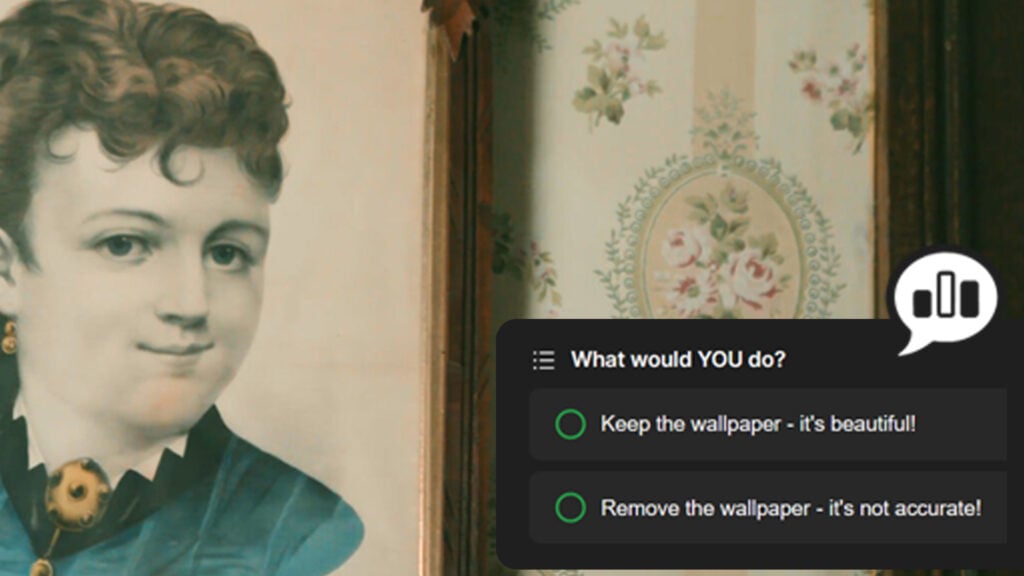“The Tenement Museum is not a fixed entity. It’s constantly changing, there’s constantly new information. There are still questions that we have about the building and the way people lived in the building and there are always new discoveries being made. In fact, I would argue that the most important artifact that the Museum owns is this building, and what we can learn from the building really informs the stories that are told.”
–Andrew Dolkart, Professor of Historic Preservation at Columbia University
Tenement Museum Collections
Wallpaper or Paint?

Every time you visit the Tenement Museum, the details you see in our apartment exhibits are the result of a lot of decision-making. The teacup in the counter, the blanket on the bed, the books on the shelf, the curtains in the window – each item placed is the result of extensive research and considerable conversation. And that conversation doesn’t end once the exhibit is finished.
Keep reading to learn how new research impacts even our oldest exhibits, and then pretend you’re the Tenement Museum, making the age-old decision: to wallpaper or not to wallpaper?
Over the last year, we’ve been hard at work stabilizing and preserving 97 Orchard Street, strengthening the foundations and developing a new apartment exhibit on the 5th floor, A Union of Hope: 1869.

Professor Dolkart, a longtime friend and collaborator at the Museum, helped us take advantage of the year-long project to examine what the building—and our ongoing research of the building—had to say about whether our current apartment exhibits might need updates. We zeroed in on the Gumpertz apartment, one of the very first created for the museum in the early 1990s. Since the opening, we’ve learned more about the family—and the apartment they lived in.
Before we get to the Gumpertz apartment, let’s talk about tenement wallpaper, which we love for its colors and patterns. The very first preservation of 97 Orchard Street in the 1980s uncovered layers upon layers of wallpaper and paint in each of the apartments, and each layer tells us so much about the building and the 7000 residents who lived here.
Listen to Professor Dolkart explain how:
While we don’t know for sure who put up the wallpaper – landlords or renters – analysis shows that the same designs were used in multiple apartments, which indicates that the landlords were responsible. Given the competition for renters, landlords felt pressure to make the apartments look as nice as possible in order to rent apartments and to make a profit.
Getting back to the Gumpertz apartment and the question at hand: is the wallpaper in the Gumpertz apartment accurate?
Initial studies of the Gumpertz apartment found many layers of wallpaper and curators decided to reproduce wallpaper from one of the earliest (i.e first layer) fragments found in the apartment. But further research told a different story.
Here is Professor Dolkart talking about the Gumpertz family and their home:
The preservation project gave us an opportunity to decide what to do next. Should we keep the wallpaper or should we take it down?
Listen to Professor Dolkart making the case for keeping the wallpaper:
If the Gumpertz apartment didn’t have wallpaper, what did they have instead?
Research reveals that in the 1860s –1880s painters at 97 Orchard used a range of pastel and brightly colored distemper or calcimine (chalk-based) paints. For parlors, many residents or landlords selected a pale blue paint. This type of paint itself was inexpensive and mass-produced, intended to be washed off every year and reapplied. But to the benefit of the Tenement Museum, many of the residents and owners simply repainted over without washing anything off, resulting in over 30 layers of paint in many rooms.
Here is Professor Dolkart making the case for removing the wallpaper and painting the parlor instead:
Imagine you’re the Tenement Museum – what would you do? Keep the wallpaper or remove it?
But you’re not the Tenement Museum – we are! What do you think we did?
Listen to Professor Dolkart share what we decided to do:
At the Tenement Museum, we are always updating our content based on new discoveries of our families and our buildings, as well as new ideas and arguments being made in the field of history. This preservation project has uncovered a whole new wealth of information about 97 Orchard Street, which helps us tell the stories of our families in deeper ways. Next time you visit the Gumpertz family, take a moment to admire the new, bright blue paint of the parlor – and see if you can find the piece of the wallpaper that remains!